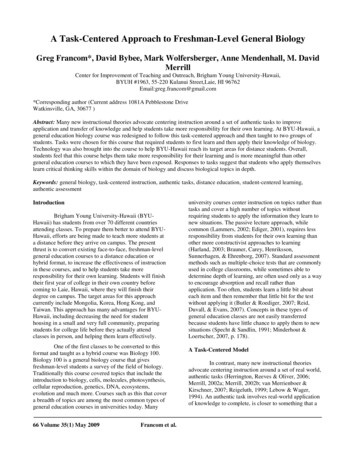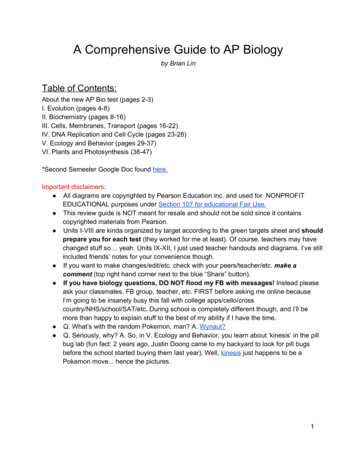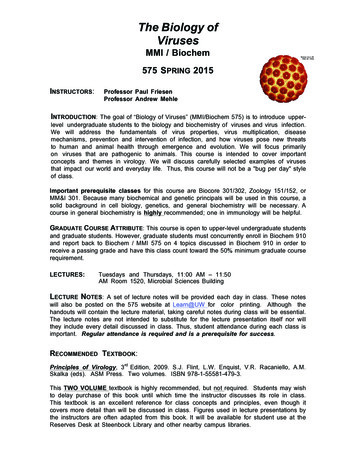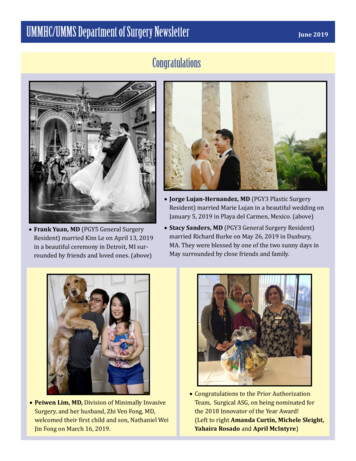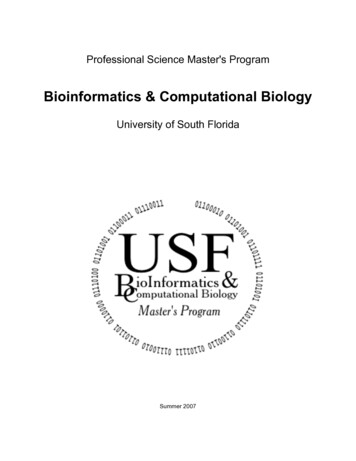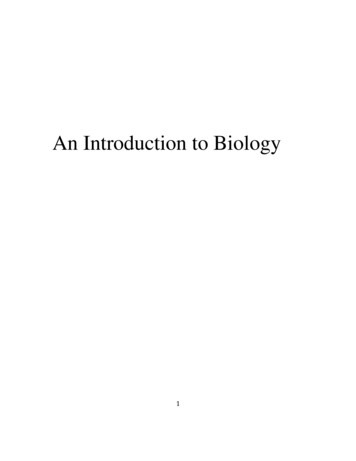
Transcription
An Introduction to Biology1
ContentsChapter 1: Introduction to BiologyChapter 2: Theory of EvolutionChapter 3: Cell and GenesChapter 4: Growth and Developmental TheoryChapter 5: Immune SystemTibetan-English TerminologyEnglish-Tibetan Terminology2
Chapter 1: Introduction to BiologyIn its broadest sense, biology is the study of living things. It can be also called as thescience of life from its objective standpoint. All living things or living organisms arestudied under this division of science. It pays attention and study on the things related toliving organisms such as organization of life, their functions, patterns and order oforganisms, growth and development of living organisms and so on. Living things havevariety of shapes, forms and functions, and biologists study life in many different waysfrom the cell at the smallest and ecosystems at large. Due to that, biology has variety ofbranches and divisions such as evolutionary biology, cellular biology, genetics, growthand developmental biology and so on.Properties of LifeWhat then do we mean by life? How is the order of living things? Although there is noexact definition of life in general, most of the living things share certain keycharacteristics. These are,1. Cellular organization. All living organisms consist of one or more cells. The cell is thebasic unit of life. Each one of them carries the basic activities of living. Little moreexplanations shall be seen in chapter 2.2. Order. All living things are highly ordered. Your body is composed of many differentkinds of cells. Each containing may complex molecular structures.3. Sensitivity. Any organisms are capable of responding to signals and stimuli from itssurroundings. Plants grow toward a source of light, and your pupils dilate when you walkinto a dark room.4. Growth, development and reproduction. Any organisms are capable of growing andreproducing, and they all possess genes or hereditary molecules that are passed to theiroffspring.5. Energy utilization. All organisms take in energy and use it to perform many kinds ofwork. Every muscle in your body is powered with energy you obtain from the food youeat.6. Evolutionary adaptation. All organisms interact with other organisms and theenvironment in ways that influence survival, and as a consequence, organisms evolveadaptations to their environments.3
7. Homeostasis. All organisms maintain relatively constant internal conditions, differentfrom their environment, a process called homeostasis.These properties are characteristics of all living organisms, and on that basis, we shallhave to examine whether things are living or not. More details are given below.Hierarchical Organisation.Is the world of living things in disorder without being organized? As it isn’t, any livingthings do seem to have hierarchical organization. Any living thing falls under ahierarchical level. The representation of level in order to have easier picture of the senseof hierarchy is called hierarchy of life. Hierarchy of life can have variety of level. Ingeneral, there is atom at the lowest level to ecology at the highest level, and so, in anutshell, there are ten levels. If we were to consider in one go from lowest to highest,atom at the lowest, above is the cell, on it is tissue, then organ, then organ system, thenorganism or person, on it is, population, then community, and ecology at the highest. Infig.(1), the earlier ones are the parts or the composition of later ones and later ones areformed out of the composition of earlier ones. For example, two or more atoms are joinedtogether to form a molecule, and certain molecules are assembled into cell, certain cellsare assembled to form tissue and likewise to the later ones. This organization is calledhierarchical organization of life. Each level is considered an organization.The Cellular Level. At the cellular level, atoms, the fundamental elements of matter,are joined together into clusters called molecules. Complex biological molecules areassembled into tiny structures called organelles, part of cells, which are assembledtogether to form cells. Nucleus and mitochondria are the basis of organelles. Asmentioned above, the cell is the basic unit of life and many organisms are composed ofsingle cells in the world. Bacteria are single cells, for example. All animals and plants, aswell as most fungi and algae, are multicellular-composed of more than one cell. Moredescriptions can be learnt from cell and gene chapter.The Organismal Level. Cells are organized into three levels of organization. The mostbasic level is that of the tissues, which are groups of similar cells that act as a functionalunit such as muscle tissues and blood tissues. Tissues, in turn, are grouped into organs,which are body structures composed of several different tissues grouped together in astructural and functional unit such as heart and brain. Your brain is an important organcomposed of zillions of nerve cells and a variety of connective tissues. At the third levelof organization, organs are grouped into organ systems. The nervous system, forexample, consists of sensory organs, the brain and spinal cord.The Populational Level. Individual organisms are organized into several hierarchicallevels within the living world. The most basic of these is the population, which is a groupof organisms of the same species living in the same place such as human population andfish population. All the populations of a particular kind of organism together form a4
species, its members similar in appearance and able to interbreed. At a higher level ofbiological organization, a biological community consists of all the populations of thedifferent species living together in one place. At the highest tier of biologicalorganization, a biological community and the physical habitat within which it livestogether constitute an ecological system, or ecosystem.Emergent PropertiesMany new properties emerge at the higher level of living hierarchy as we climb up thelevel from lower to higher level. These are called emergent properties. For example, wecan see the properties and energy in a cell that has been formed from the aggregates of somany molecules, which are not present in single molecule. For example, there areproperties in molecule such as protein that are not present in atoms that comprised it.That is, if we take a simple example of diamond and coal that are composed of samecarbon molecule and even though they are formed differently and yet they have so muchdifference in terms of their properties and characteristics. We can know from thehierarchy nature of life from the emergent property of life. Note: HierarchicalOrganisation and emergent property are the two most important theories in biology. So,you are asked to heed upon these.5 Core Themes in all of biology.Organisation of Life. The Cell TheoryAs it was stated earlier, all organisms are composed of cells, life’s basic units. Despitehaving huge differences in sizes and shapes of all the living organisms from the tiniest living organismsof a single-celled organisms to the largest 10 kilometers-squard size fungi, ArmillariaOstoyae, are consist of cells. This conclusion forms the basis of what has come to beknown as the cell theory. The cell theory, one of the basic ideas in biology, is thefoundation for understanding the reproduction and growth of all organisms. The celltheory gives two important conclusions. Firstly, it concluded that all living organismsconsist of cells and secondly, all cells come from earlier cells. Description of thediscovery of cell follows later.Continuity of life: The Molecular Basis of InheritanceEven the simplest cell that cannot be seen by naked eye is incredibly complex-moreintricate than a computer. Cells have many different types of shapes, basis and functionsand so what specifies a particular cell is encoded inside a nucleus of cell called gene.Gene specifies work, shapes, functions and energy of cells. Genes are formed aside DNA.DNA is a long, cable-like molecule, two long chains of building blocks, callednucleotides, wound around each other. Winding around each other like the rails of spiralstaircase, the two strands of DNA make a double helix.5
The continuity of life from one generation to the next-heredity - depends upon the faithfulcopying of a cell’s DNA into daughter cells. So, DNA is a basic unit of molecule ofheredity characteristics.The Correlation of structure and function.Structure and function are correlated at all levels of biological organization. This theme isa guide to the anatomy of life at its many structural levels, from molecules to organisms.Analyzing a biological structure gives us clues about what it does and how it works.Conversely, knowing the function of a structure provides insight about its construction.We can see the correlation of structure and shape of bird’s wings and their functionsclearly. The aerodynamically efficient shape of a bird’s wing, chest muscle for flightefficacy, the width of chest bones to build up the muscles, air bags in the skeleton tolighten up the weight of body helps in the flight of a bird.Diversity of Life: Evolutionary ChangeThe nature of diversity is a hallmark of life. Biologists have identified and named about1.5 million species, including over 260,000 plants, almost 50,000 vertebrates (animalswith backbones), and more than 750,000 insects. Thousands of newly identified speciesare added to the list each year. Estimates of the total diversity of life range from about 5million to over 100 million species.Biologists divide life’s great diversity into three great groups, called domains: Bacteria,Archaea, and Eukarya. The domains Bacteria and Archaea are composed of prokaryotes(single-celled organisms with little internal structure), while domain Eukarya is made upof eukaryotes, organisms composed of a complexly organized cell or multiple complexcells. However, Archaea seem more closely related to Eukarya than to Bacteria. Withinthe Eukarya are four main groups called kingdoms. Kingdom Animalia includes humanbeing; all plants are included in Kingdom Plantae. Kingdoms are also categorized intophylum, phylum to class, class to order, order to family, family to genus, genus tospecies. These are 8 great classification of life. If we ask about how do such diverse lifeforms of living organism form? All biologists unanimously claim it to happen through theevolution.Unity of Life: Evolutionary ConservationBiologists believe that all living things have descended from some simple cellularcreature that arose about 2.5 billion years ago. Some of the characteristics of that earliestorganism have been preserved in all things alive today. The storage of hereditaryinformation in DNA, for example, is common to all living things. Also, all eukaryotespossess a nucleus that contains chromosomes. The retention of these conserved6
characteristics in a long line of descent usually reflects a fundamental role in the biologyof the organism, one not easily changed once adopted.These five properties are the core themes in biology that are visible and we have toanalyse any biological theories with respect to these themes.Debating Questions/DiscussionsReview Questions1. What are the seven important properties of life?2. Identify each 10 hierarchy of life.3. What is the basic building block of life? Why is it so?4. How do we understand by the emergent property? Explain with an example.5. Identify five core themes that form the basis for all of biology.6. Hierarchy of life and Core themes are very important while studying biology.Why?7
Chapter 2: Evolutionary Theory/ Theory of EvolutionGenerally speaking, Biology is a diverse and has many sub-categories yet thisintroductory book is a preliminary textbook and thereby it will present an essentialaccount of biology chapters in year 2 through to year 6. That is, the theory of evolution,cell and gene theory, growth and reproduction theory and immune system. The briefhistorical events at the first place and secondly, the general meaning.Brief historical context for Evolutionary Theory.A number of classical Greek philosophers believed in the gradual evolution of life. Butthe philosophers who influenced Western culture most, Plato and his student Aristotle,held opinions that opposed any concept of evolution in which species are permanent, areperfect, and do not evolve. In Judeo-Christian culture, the Old Testament account ofcreation fortified the idea that species were individually designed and permanent. In the1700s, biology in Europe and America was dominated by natural theology, a philosophydedicated to discovering the Creator’s plan by studying nature. Natural theologians sawthe adaptations of organisms as evidence that the Creator had designed each and everyspecies for a particular purpose. A major objective of natural theology was to classifyspecies in order to reveal the steps of the scale of life that God had created.In 18th century, Carolus Linnaeus, a Swedish physician and botanist, sought to discoverorder in the diversity of life “for the greater glory of God”. Linnaeus was the founder oftaxonomy, the branch of biology concerned with naming and classifying the diverseforms of life. He developed the two-part, or binomial, system of naming organismsaccording to genus and species that is still used today. In addition, Linnaeus adopted asystem for grouping similar species into a hierarchy of increasingly general categories.For example, similar species are grouped in the same genus, similar genera (plural ofgenus) are grouped in the same family, and so on. To Linnaeus, clustering similar speciestogether implied no evolutionary kinship, but a century later his taxonomic system wouldbecome a focal point in Darwin’s arguments for evolution.In the early part of 19th century and late 18th century, natural scientists have startedstudying fossils. Fossils are remains or impressions of a prehistoric organism preserved inpetrified form or as a mold or cast in rock. There were many opinions and arguments onthe geological formation and how life evolved on it by relying on fossils.Paleontology, the study of fossils, was largely developed by French anatomist GeorgesCuvier. Realizing that the history of life is recorded in strata containing fossils, hedocumented the succession f fossil species in the Paris Basin. He noted that each stratumis characterized by unique group of fossil species, and that the deeper (old) the stratum,the more dissimilar the flora (plant life) and fauna (animal life) are from modern life.Cuvier even recognized that extinction had been a common occurrence in the history oflife. From stratum to stratum, new species appear and others disappear. Yet Cuvier was a8
staunch opponent to the evolutionists of his day. Instead, he advocated catastrophism,speculating that each boundary between strata corresponded in time to a catastrophe, suchas flood or drought that had destroyed many of the species living there at that time. Heproposed that these periodic catastrophes were usually confined to local geographicalregions, and that the ravaged region, such as mountain sliding to form ground andbulging of planes forming mountain, was repopulated by species immigrating from otherareas.The leading geologist of Darwin’s era, a Scot, named Charles Lyell had criticized thetheory of gradualism. He incorporated Hutton’s gradualism into a theory known asuniformitarianism. The term refers to Lyell’s idea that geological processes have notchanged throughout Earth’s history. Thus, for example, the forces that build mountainsand erode mountains and the rates at which these forces operate are the same today as inthe past. Darwin was strongly influenced by two conclusions that followed directly fromthe observations of Hutton and Lyell. First, if geological change results from slow,continuous actions rather than sudden events, then Earth must be very old, certainly mucholder than the 6000 years assigned by many theologians on the basis of biblical inference.Second, very slow and subtle processes persisting over a long period of time can causesubstantial change. Darwin was not the first to apply the principle of gradualism tobiological evolution, however.Toward the end of the 18th century, several naturalists suggested that life had evolvedalong with the evolution of Earth. But only one of Darwin’s predecessors developed acomprehensive model that attempted to explain how life evolves: Jean Baptiste Lamarck.Lamarck published his theory of evolution in 1809, the year Darwin was born. He agreedthat living organisms on Earth evolved from much simpler nature toward greatercomplexity and he proposed to explain specific adaptations evolve. It incorporated twoideas that were popular during Lamarck’s era. The first was use and disuse, the idea thatthose parts of the body used extensively to cope with the environment become larger andstronger while those that are not used deteriorate. Among the examples Lamarck citedwere a blacksmith developing a bigger bicep in the arm that wields the hammer and agiraffe stretching its neck to reach leaves on high branches. The second idea Lamarckadopted was called the inheritance of acquired characteristics. In this concept of heredity,the modifications an organism acquires during its lifetime can be passed along to itsoffspring. The long neck of the giraffe, Lamarck reasoned, evolved gradually as thecumulative product of a great many generations of ancestors stretching ever higher. Thereis, however, no evidence that acquired characteristics can be inherited.Not only had Charles Darwin (1809-1882) established firmly the evolutionary theory butalso showed clearly how the evolution occurs and therefore transformed it into anessential claim of biology. Even as a boy he had a consuming interest in nature. Darwinwas 22 years old when he sailed for five years from Great Britain aboard HMS Beagle inDecember 1831 across the seas on his voyage to different continents and islands of theworld. During this long voyage, Darwin had the chance to observe and study in detail a9
wide variety of birds, plants, flowers, fossils, etc., on those regions of the world. Duringthis long voyage, he found the evidence to change the fundamental claims of evolution.Soon after returning, Darwin started reassessing all the information and evidence that hehad observed during the voyage of the Beagle and finally came up with the idea that theexistential diversity of life on earth happened from evolution and by means of naturalselection. That is, evolution of living organisms occurs by means of natural selection andnatural selection itself occurs through organisms’ adaptation to its environment. Itoccurred to him that a new species could arise from an ancestral form by the gradualaccumulation of adaptations to a different environment. Darwin developed his famousideas of evolution and compiled with extensive evidence to publish the book titled TheOrigin of Species in 1859. After the publication of the book, it spread wide and open andbecame a manifesto of biology.Descent with ModificationSecondly, in order to talk about general meaning of evolution, there are five things to talkabout. These are, descent with modifications, variation, natural selection, adaptation andorigin of species.Darwin perceived unity in life, with all organisms related through descent from someunknown prototype that lived in the remote past. As the descendants of that inauguralorganism spilled into various habitats over millions of years, they accumulated diversemodifications, or adaptations, that fit them to specific ways of life. Such descent ofexternal phenotypic characteristics and internal genetic variation unto descendants iscalled descent with modification. This is the core idea of Darwin’s view on the nature oflife and comprised the views of the descent of genetic based ancestry characteristics ontodescendants.If asked, can it be possible to pass on all the characteristics of ancestors to descendants,which is not as genetic based characteristics cannot be passed down. For example, inhuman being, colour of eyes and skin, blood type, baldness and so forth are transferablecharacteristics. Most of the characteristics that have been acquired through learning andother factors in this life are not transferrable such as big arms of blacksmith anddegeneration of organs due to concussion.Transferrable characteristics are passed down from parent to offspring through DNA, agene-holding molecule. More details will come up in chapter 3. So, because of thechanges in the transferrable characteristics due to causes and conditions, newcharacteristics are passed onto descendants and gradually spread across the population ofthat organism, and thereby evolution takes place in the population of that organism.Variation10
Secondly, variation refers to differences that are visible in the population. When we payattention to our surrounding environment, we can see so many different variations amongpopulation such as differences in skin colour, facial structure, body height and so on inhuman population, different characteristics in same species of domestic animals anddifferent types of colour and size in same species of flowers. Visible characteristics aregiven the term dominant gene and that characteristic based genes are referred to asgenetic composition. We can predict the differences in genetic composition thepopulation from the differences in dominant gene of population and differences indominant gene emerge from the differences occurring in the genetic composition. Therehappens change in genetic composition of the population with time and spread across thepopulation and when it brings change in the nature of population, it is considered thatevolution has happened in the population.And then if we asked by depending on what has the variation occurred? We can say thatit occurred from the changes in genetic composition, gene alteration from mating and alsofrom the gene flow, gene flow from one population to another due to the migrationbetween populations. More details will come up in the second year chapters. Variation isone important cause of the happening of evolution and that evolution will not occur ifthere are no diverse variations in the population.And if we are asked about the way evolution occurred in population with such variation,the way of happening of this evolution is called natural selection that is explained below.Natural SelectionThirdly, there are three ways by which we can say about natural selection and these are:general meaning, examples of its occurring and types.At first, the meaning or definition. The organisms that have characteristics that let themadapt better to the environment than rest of the same species have better chance ofsurvival and reproduction thereby having more descendants and due to that have chanceof prolonging the advantageous genetic composition onto future generations. In this way,the genes of the organisms with advantageous traits are preserved and passed ontodescendants. This is called Natural Selection.One popular empirical example of natural selection is that during the industrialrevolution, lot of factories were running in so many places producing smokes from theburning of coal. Nearby forests were turned black by the smokes. There were twodifferent kinds of moth, white and black. Because of the darkening of trees and branchesfrom the black smokes, it gave favourable conditions for the survival of black mothrelative to white moth and thereby can survive longer and advantageous in terms ofreproduction. Due to the similar colour of moths and tree branches, birds cannot see and11
so it’s easy to escape from the danger. And because it’s easier to see white moths onblack branches, they became prey to birds. Gradually, the empirical evidence of thetransformation of earlier population of mixed moths to black population is one of thesimplest and most popular examples of natural selection.Secondly, if we were to show how natural selection would occur through example, suchas there are few factors for natural selection to occur in the population of beetles.First condition is that of variation in traits. For example, there are many different kinds ofphysical colour for beetles such as green and brown, and white and black traits inpopulation of moths.Second condition is that of the differences in the hereditary reproduction. Not only canthe population not expand limitlessly but also can it extend the full use of the ability forhereditary reproduction and therefore there emerges differences in the hereditaryreproduction in the population of organisms. In this example, because of the visibility ofgreen beetles, they became prey to the birds and so the ability for the hereditaryreproduction is comparatively less than the brown beetles.Third condition. Traits have genetically inherited nature. For example, brown beetlesreproduce brown offspring and green beetles reproduce green offspring because thesecharacteristics have genetic basis.Consequently, organisms with traits that give them an advantage over their competitorsare more likely to pass on their traits to the next generation than those with traits that donot confer an advantage thereby spreading within the population. The whole organismsin the population turn into the population with such traits. And if there are variations intraits within the population and that there are variations in the reproduction of eachorganism of the population, traits having genetically inherited nature, then consequentlyit follows that evolution occurs through the means of natural selection.Thirdly when we talk about different types of natural selection, there is directionalselection, disruptive selection, stabilizing selection, sexual selection, artificial selectionand so forth. When we ask about the consequences of evolution by means of themechanism of natural selection, generally speaking, although evolution do influence thefeatures and behavior of organisms, the most visible consequences are the organism’sbehavioral adaptation and physical adaptation. Therefore, we will discuss little bit aboutadaption.AdaptationFourthly, there are three things in order to talk about adaptation, the nature of adaptation,and mechanism of adaptation and consequences of adaptation.Firstly, adaptation is the process that makes the organisms better suited to their habitat.12
Secondly, Adaptedness is the state of being adapted: the degree to which an organism isable to live and reproduce in a given set of habitats. Organisms have to compete forsuitable conditions to survive and reproduce and in undergoing such processes, organismshaving traits that adapt to the environment are being naturally selected and pass onto nextgeneration.Thirdly the regarding consequences of adaptation, adaptation enables or enhances theprobability of that organism surviving and reproducing. And if the organism lacksadaptive traits then their survival and reproduction weakens. Therefore, adaptation helpsincreasing the population quantity.The Origin of LifeSixth thing regarding the origin of life, in general, scientists popularly claim that theuniverse formed about 13.7 billion years ago and Earth formed about 4.5 billion yearsago. Scientists cannot recognise the exact dateline of the origin of life and neither havethey found the standard evidence. According to the claim, when the earth started forming,all the inner and outer parts are made up of fire and gradually the temperature starteddropping.Earth is situated at a suitable distance from Sun and many factors such as huge waterbodies have conditioned for life to form on it and developed continuously. PlanetsMercury and Venus are too close to Sun and Planets Mars and Jupiter are too far fromSun and so pose challenges to form life on these planets.Carbon is the necessary atom for all organisms and it is estimated that it has conditionedthe origin of diverse forms of life in the early part on earth. One of the primary origins ofcarbon is from the vapours from volcanic eruption. Carbon and hydrogen, oxygen,nitrogen are joined together to form an important form of chemical called amino acid, thebuilding block of protein.Since amino acid is the building block of protein, it is also the basis of early forms of life.Enzymes and catalyst made up of proteins become inevitable for organisms to carry ontheir different bodily functions. Generally, it is a phenomenon of organisms to developfrom simplest to more complex state. For example, it is like even though organismsoriginated from very small size and number yet gradually expanded and become diversein nature.What is clear for us is that an organism that depends on other cell cannot be considered asthe origin of life. This is because one has to depend on other organism in order to surviveand reproduce and so it cannot be claim as origin from the state of earlier life form.However virus and other organisms that are dependent on other cell can be regarded asformed after the start of the evolution of living things.13
We have to consider something physical as living thing on this earth when it takesnutrients from others and starts breathing and that is to consider from the formation ofamino acid through chemical reaction in the oceans and lakes on the planet dating back to3 billion years. But some scholars say that life originated from other exo-planet and notfrom this earth.Some researchers have found the evidence of the formation of RNA molecule throughchemical reactions in the early stage of the world. And some researchers estimate that lifehas to be considered from the point of conception of reproduction ability to acombination of chemical substances. At present, so many scientists conduct differentkinds of experiment in laboratory to obtain new understanding on the formation of lifefrom the beginning and strive to make the type of chemical
Generally speaking, Biology is a diverse and has many sub-categories yet this introductory book is a preliminary textbook and thereby it will present an essential account of biology chapters in year 2 through to year 6. That is, the theory of evolution, cell and gene theory, gr


